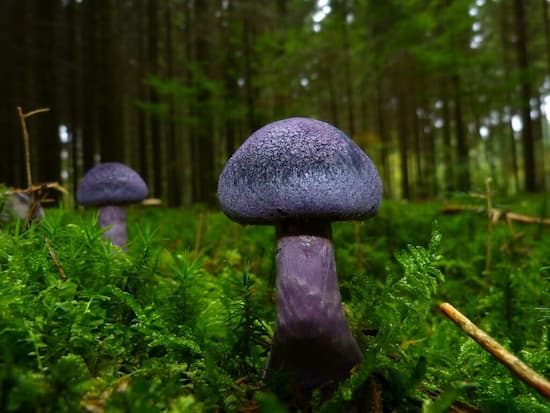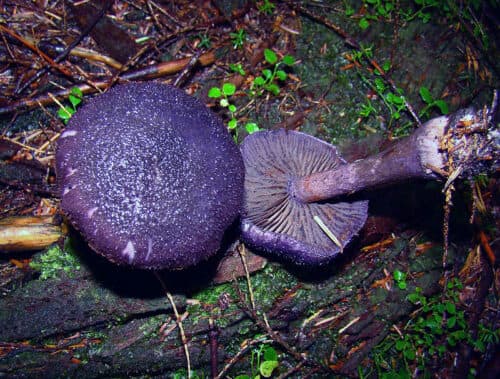The Violet Webcap mushroom, scientific name Cortinarius violaceus, is a strikingly beautiful fungus known for its deep purple cap and stem.
In this article, you are going to learn how to identify Violet webcaps, where to find them, and whether you can use them for culinary purposes.
What is Violet Webcap Mushroom
It’s a member of the Cortinarius genus, which comprises a large group of fungi commonly referred to as webcaps due to the cobweb-like veil (cortina) covering their young gills.

While Violet Webcaps are visually appealing, experts do not recommend it for consumption, as some species within the Cortinarius genus are toxic.
Identifying edible mushrooms with certainty requires expertise, so it’s best to leave mushroom foraging to experts unless you’re very knowledgeable about mycology.
Where To Find Cortinarius Violaceus?
You can find Violet Webcap in temperate regions of North America and Europe, appearing from late summer to autumn.
They grow in mixed woodlands, especially under hardwood trees such as beech and oak. They prefer moist, acidic soil, so you might spot them in areas with decaying plant matter, like forest floors or along trails.
When foraging for Violet Webcaps or any wild mushrooms, it’s essential to exercise caution and ensure proper identification, as mistaking them for toxic varieties can have serious consequences.
How To Identify Cortinarius Violaceus?
Identifying the Violet Webcap mushroom (Cortinarius violaceus) requires attention to several key features:
- Cap: The cap of the Violet Webcap is typically deep purple or violet in color, though it can sometimes appear more reddish-brown when young. It is smooth and convex when young, becoming flatter with age. The cap can range from 5 to 15 centimetres in diameter.
- Gills: The gills of the Violet Webcap are initially covered by a cobweb-like veil (cortina) in young specimens. As the mushroom matures, the veil breaks, leaving a rusty-brown spore print on the gills. The gills are adnate to slightly decurrent, meaning they attach to the stem or curve slightly downward.
- Stem: The stem of the Violet Webcap is typically the same colour as the cap, ranging from purple to violet or reddish-brown. It is often cylindrical and fibrous, sometimes with a slightly bulbous base. The stem can grow up to 10 centimetres tall and 1–2 centimetres thick.
- Veil: In young specimens, the Violet Webcap has a distinct cortina, or cobweb-like veil, covering the gills. As the mushroom matures, this veil typically breaks, leaving remnants on the stem or nearby vegetation.
- Spore Print: Obtaining a spore print can also aid in identification. To do this, place the cap of a mature mushroom, gills facing down, on a piece of white paper or glass overnight. In the case of the Violet Webcap, the spore print will be rusty-brown.

Is Violet Webcap Mushroom Edible?
The edibility of the Cortinarius violaceus is a topic of debate among mycologists and foragers. Some sources suggest that it may be edible when cooked thoroughly.
However, others advise against consuming it due to potential toxicity and the risk of mistaken identity with similar-looking but toxic mushrooms within the Cortinarius genus.
Cortinarius mushrooms, including the Violet Webcap, contain a variety of compounds, including toxins that can cause gastrointestinal upset or other adverse reactions in some individuals. Additionally, certain species within the Cortinarius genus are toxic or even deadly if ingested.
Given the potential risks associated with consuming Cortinarius mushrooms and the difficulty in confidently identifying them, it is generally recommended to avoid consuming the cortinarius violaceus and other wild mushrooms unless you are an experienced mycologist.
Violet Webcap Mushroom Look Alikes
Here are some mushrooms that may resemble the Violet Webcap and are commonly cited as look-alikes:
- Cortinarius alboviolaceus: This species shares a similar appearance, featuring a purple or violet cap and stem. However, Cortinarius alboviolaceus typically exhibits lighter coloration compared to Cortinarius violaceus, and its cap may have a more conical shape.
- Cortinarius iodes: Also known as the Viscid Violet Cort, this mushroom bears a resemblance to the Violet Webcap, especially in its coloration. However, Cortinarius iodes tends to develop a slimy or sticky cap when moist, which sets it apart from Cortinarius violaceus.
- Cortinarius hercynicus: Another species within the Cortinarius genus that looks quite similar. It features a purple to violet cap and stem. However, its cap is often more convex and less flattened than that of Cortinarius violaceus, and it may lack the web-like veil remnants on the stem.
- Tricholoma focale: This mushroom species shares certain similarities with the Violet Webcap, including a purple to violet cap. However, Tricholoma focale typically displays a smoother cap surface compared to Cortinarius violaceus, and it does not have the web-like veil remnants on the stem.
- Lepista nuda: Also known as the Wood Blewit, this mushroom has a similar coloration, with shades of purple or lilac. However, Lepista nuda can be distinguished by its broader, more convex cap and its tendency to grow in grassy areas rather than woodland habitats.
What Are The Negative Effects of Violet Webcap?
The Violet Webcap mushroom (Cortinarius violaceus) is not one of the most toxic mushrooms, but it is part of the Cortinarius genus, which contains many species that are toxic.
Consuming any mushroom from the Cortinarius genus, including the Violet Webcap, can potentially lead to various negative effects, including:
- Gastrointestinal Distress: Many Cortinarius species contain toxins that can cause symptoms such as nausea, vomiting, diarrhea, and abdominal pain.
- Organ Damage: In severe cases, ingestion of toxic Cortinarius mushrooms can lead to damage to internal organs, particularly the liver and kidneys.
- Neurological Symptoms: Certain toxins found in Cortinarius mushrooms can affect the nervous system, leading to symptoms such as dizziness, confusion, hallucinations, or seizures.
- Allergic Reactions: Some individuals may experience allergic reactions to certain compounds found in Cortinarius mushrooms, leading to symptoms such as itching, hives, or difficulty breathing.


